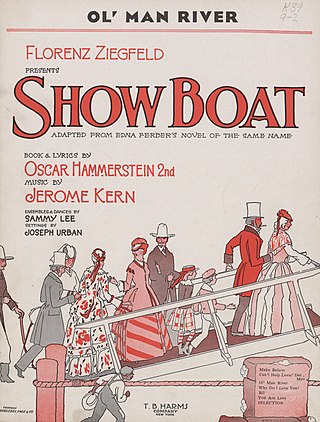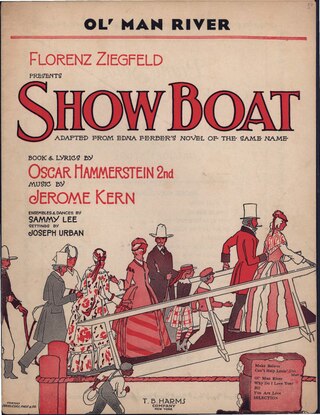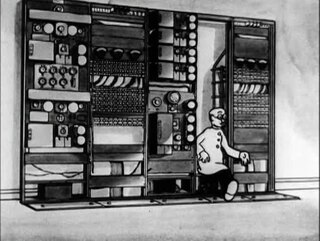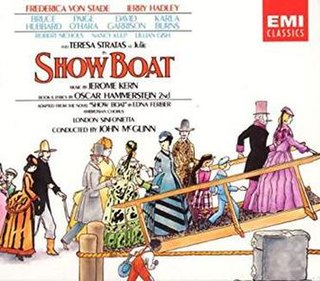
The Broadway Melody, also known as The Broadway Melody of 1929, is a 1929 American pre-Code musical film and the first sound film to win an Academy Award for Best Picture. It was one of the early musicals to feature a Technicolor sequence, which sparked the trend of color being used in a flurry of musicals that would hit the screens in 1929–1930.

The Jazz Singer is a 1927 American part-talkie musical drama film directed by Alan Crosland and produced by Warner Bros. Pictures. It is the first feature-length motion picture with both synchronized recorded music and lip-synchronous singing and speech. Its release heralded the commercial ascendance of sound films and effectively marked the end of the silent film era with the Vitaphone sound-on-disc system, featuring six songs performed by Al Jolson. Based on the 1925 play of the same title by Samson Raphaelson, the plot was adapted from his short story "The Day of Atonement".

Lincoln Theodore Monroe Andrew Perry, better known by the stage name Stepin Fetchit, was an American vaudevillian, comedian, and film actor of Jamaican and Bahamian descent, considered to be the first black actor to have a successful film career. His highest profile was during the 1930s in films and on stage, when his persona of Stepin Fetchit was billed as the "Laziest Man in the World".

Show Boat is a musical with music by Jerome Kern and book and lyrics by Oscar Hammerstein II. It is based on Edna Ferber's best-selling 1926 novel of the same name. The musical follows the lives of the performers, stagehands and dock workers on the Cotton Blossom, a Mississippi River show boat, over 40 years from 1887 to 1927. Its themes include racial prejudice and tragic, enduring love. The musical contributed such classic songs as "Ol' Man River", "Make Believe", and "Can't Help Lovin' Dat Man".

"Ol' Man River" is a show tune from the 1927 musical Show Boat with music by Jerome Kern and lyrics by Oscar Hammerstein II, who wrote the song in 1925. The song contrasts the struggles and hardships of African Americans with the endless, uncaring flow of the Mississippi River. It is sung from the point of view of a black stevedore on a showboat, and is the most famous song from the show. The song is meant to be performed in a slow tempo; it is sung complete once in the musical's lengthy first scene by the stevedore "Joe" who travels with the boat, and, in the stage version, is heard four more times in brief reprises. Joe serves as a sort of musical one-man Greek chorus, and the song, when reprised, comments on the action, as if saying, "This has happened, but the river keeps rolling on anyway."

The Singing Fool is a 1928 American sound part-talkie musical drama motion picture directed by Lloyd Bacon which was released by Warner Bros. In addition to sequences with audible dialogue or talking sequences, the film features a synchronized musical score and sound effects along with English intertitles. The soundtrack was recorded using the Vitaphone sound-on-disc system. The film stars Al Jolson and is a follow-up to his previous film, The Jazz Singer. It is credited with helping to cement the popularity of American films of both sound and the musical genre. The film entered the public domain on January 1, 2024.
Show Boat is a 1936 American romantic musical film directed by James Whale, based on the 1927 musical of the same name by Jerome Kern and Oscar Hammerstein II, which in turn was adapted from the 1926 novel of the same name by Edna Ferber.
Victor Baravalle (1885–1939) was an Italian-born composer, music director, and conductor, best known for his work on both the stage and film productions of the Jerome Kern and Oscar Hammerstein II musical Show Boat.
A part-talkie is a sound film that includes at least some "talking sequences" or sections with audible dialogue. The remainder of the film is provided with a synchronized musical score with sound effects. These films more often than not contain a main theme song that is played during key scenes in the film and is often sung offscreen on the musical soundtrack. During the portion without audible dialogue, speaking parts are presented as intertitles—printed text briefly filling the screen—and the soundtrack is used only to supply musical accompaniment and sound effects.
"Can't Help Lovin' Dat Man" with music by Jerome Kern, and lyrics by Oscar Hammerstein II, is one of the most famous songs from their classic 1927 musical play Show Boat, adapted from Edna Ferber's 1926 novel.
Gaylord Ravenal is the leading male character in Edna Ferber's 1926 novel Show Boat, in the Jerome Kern-Oscar Hammerstein II musical of the same name based on the novel, and in the films and other adaptations of the story. He is a handsome, compulsive riverboat gambler, who becomes the leading man of the showboat Cotton Blossom at the same time that Magnolia Hawks, the captain's daughter, becomes the leading lady. In the novel, this happens several years after the illegally married mulatto Julie Dozier and her white husband Steve Baker have left the show on the boat. In the musical, it happens immediately after Julie and Steve are forced to leave the show. In the musical, Magnolia and Gaylord meet in the first scene of the show, before Julie and Steve leave, as Kern and Hammerstein wished to bring Gaylord into the story early. In the novel the two meet right after Gaylord is hired as leading man, long after Julie and Steve have left.

Therese Gardella was an American performer on the stage and screen whose stage persona was Aunt Jemima. She was of Italian descent. She performed on both stage and screen, usually in blackface. Tess was born in Glen Lyon, Pennsylvania, to John and Louisa Gardella. She came to New York City in 1918, singing in dance halls and nightclubs and also political rallies.
Julie Dozier is a character in Edna Ferber's 1926 novel Show Boat. In the Jerome Kern and Oscar Hammerstein II's classic musical version of it, which opened on Broadway on December 27, 1927, her stage name is Julie La Verne. She is exposed as Julie Dozier in Act I. In Act II, Julie has changed her name, this time to Julie Wendel.

Show Boat is a 1951 American musical romantic drama film, based on the 1927 stage musical of the same name by Jerome Kern (music) and Oscar Hammerstein II, and the 1926 novel by Edna Ferber. It was made by MGM, adapted for the screen by John Lee Mahin, produced by Arthur Freed and directed by George Sidney.

Finding His Voice (1929) is a short film created as an instructional film on how the Western Electric sound-on-film recording system worked. Recording stars Billy Murray and Walter Scanlan, uncredited, provide the speaking and singing voices. Murray also provided the voice for the Fleischer Studios character Bimbo.

Show Boat is a 1926 novel by American author and dramatist Edna Ferber. It chronicles the lives of three generations of performers on the Cotton Blossom, a floating theater on a steamboat that travels between small towns along the banks of the Mississippi River, from the 1880s to the 1920s. The story moves from the Reconstruction Era riverboat to Gilded Age Chicago to Roaring Twenties New York, and finally returns to the Mississippi River.
"Make Believe" is a show tune from the 1927 Broadway musical Show Boat with music by Jerome Kern and lyrics by Oscar Hammerstein II.
"The Lonesome Road" is a 1927 song with music by Nathaniel Shilkret and lyrics by Gene Austin, alternately titled "Lonesome Road", "Look Down that Lonesome Road" and "Lonesome Road Blues." It was written in the style of an African American folk song.

Fox Movietone Follies of 1929, also known as Movietone Follies of 1929 and The William Fox Movietone Follies of 1929, is an American black-and-white and color pre-Code musical film released by Fox Film Corporation.

Show Boat is a 221-minute studio album of Jerome Kern's musical, performed by a cast headed by Karla Burns, Jerry Hadley, Bruce Hubbard, Frederica von Stade and Teresa Stratas with the Ambrosian Chorus and the London Sinfonietta under the direction of John McGlinn. It was recorded from June 1 to August 31, 1987 at Abbey Road Studios in London.

















